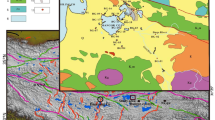Abstract.
Boron concentrations of the CO2-rich thermal waters in western Anatolia have a wide range of 1–63 mg/l. Cl/B molal ratios of high temperature waters (>150 °C) have low values ranging from 1 to 10. In low-temperature thermal waters (<150 °C), with the exception of samples that have some seawater, Cl/B ratios range from 2 to 88. The positive correlation between HCO3 and B values for thermal waters means that B concentrations in thermal waters are also associated with the dissolution of carbonates. In addition to the water–rock interaction, boron in thermal waters is probably controlled by the contribution of B by degassing of magma intrusives. Sericite, illite and tourmaline minerals, which are abundant in Menderes Massif rocks, are considered to be the main reason for the high boron contents. High B concentrations of thermal waters causes environmental problems in groundwaters and surface waters in some agricultural areas of western Anatolia. Re-injection of thermal waters to the reservoir is the best way to dispose of the geothermal wastewater and prevent contamination problems.
Similar content being viewed by others
Author information
Authors and Affiliations
Additional information
Electronic Publication
Rights and permissions
About this article
Cite this article
Gemici, Ü., Tarcan, G. Distribution of boron in thermal waters of western Anatolia, Turkey, and examples of their environmental impacts. Env Geol 43, 87–98 (2002). https://doi.org/10.1007/s00254-002-0608-x
Received:
Accepted:
Issue Date:
DOI: https://doi.org/10.1007/s00254-002-0608-x




